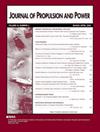Prediction of Burning Characteristics of Dihydroxyglyoxime Composite Propellant
IF 2.4
4区 工程技术
Q2 ENGINEERING, AEROSPACE
引用次数: 0
Abstract
An optimized engine start procedure is critical to the successful operation of a liquid rocket engine in launch vehicles. A solid propellant gas generator is widely adopted for the turbine starter during engine startup, and ammonium nitrate and ammonium perchlorate propellants are conventionally used for this purpose. However, these propellants have shortcomings such as high flame temperature, corrosive combustion residues, and low ignitability. In this study, a dihydroxyglyoxime (DHG)-based propellant was applied to turbine starters. The burning rate, characteristic velocity, and combustion temperature of the DHG propellant were evaluated using motor tests. The DHG-based propellant burned 3–11% slower in motor firing tests than that in strand burner tests, and an inversely proportional relationship was observed between the strand burn rate and the burning rate factor (ratio between motor burning rate measurement and strand burner prediction). The temperature sensitivity of the burning rate factor was found to be 0.23–0.24%/°C, and the pressure sensitivity of the characteristic velocity was 0.48–0.50%/MPa. These burning characteristics of the DHG-based propellant from static evaluations provide the evolution of the chamber pressure and the mass flow rate versus the time of the motor using internal ballistic analysis.二羟基乙氧肟复合推进剂燃烧特性预测
发动机启动过程的优化是液体火箭发动机成功运行的关键。发动机启动时涡轮启动器广泛采用固体推进剂气体发生器,通常使用硝酸铵和高氯酸铵推进剂。然而,这些推进剂存在火焰温度高、燃烧残留物腐蚀性强、可燃性低等缺点。本研究将一种基于二羟基乙氧肟(DHG)的推进剂应用于涡轮起动器。通过发动机试验对DHG推进剂的燃烧速率、特征速度和燃烧温度进行了评价。在发动机点火试验中,dhg基推进剂的燃烧速度比在束状燃烧器试验中慢3-11%,并且束状燃烧器燃烧速度与燃烧速度因子(电机燃烧速度测量值与束状燃烧器预测值之比)成反比关系。燃烧速率因子的温度敏感性为0.23-0.24% /℃,特征速度的压力敏感性为0.48-0.50% /MPa。这些基于dhg推进剂的燃烧特性从静态评估中提供了腔室压力和质量流量随发动机时间的演变,使用内弹道分析。
本文章由计算机程序翻译,如有差异,请以英文原文为准。
求助全文
约1分钟内获得全文
求助全文
来源期刊

Journal of Propulsion and Power
工程技术-工程:宇航
CiteScore
4.20
自引率
21.10%
发文量
97
审稿时长
6.5 months
期刊介绍:
This Journal is devoted to the advancement of the science and technology of aerospace propulsion and power through the dissemination of original archival papers contributing to advancements in airbreathing, electric, and advanced propulsion; solid and liquid rockets; fuels and propellants; power generation and conversion for aerospace vehicles; and the application of aerospace science and technology to terrestrial energy devices and systems. It is intended to provide readers of the Journal, with primary interests in propulsion and power, access to papers spanning the range from research through development to applications. Papers in these disciplines and the sciences of combustion, fluid mechanics, and solid mechanics as directly related to propulsion and power are solicited.
 求助内容:
求助内容: 应助结果提醒方式:
应助结果提醒方式:


